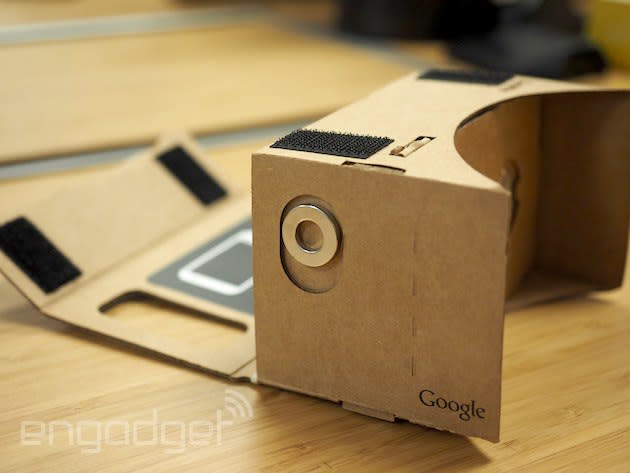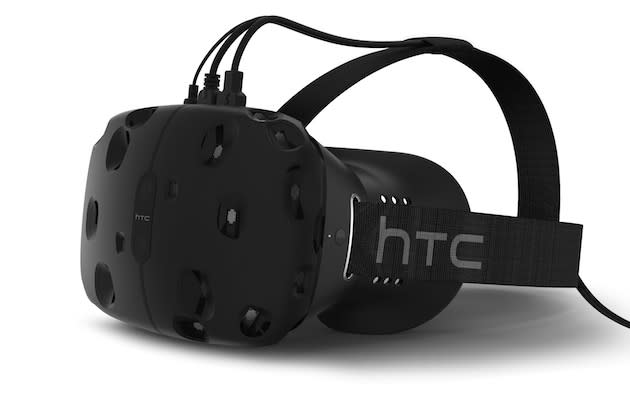How serious are you about virtual reality?

The absolute best/worst virtual reality stock photo we could find
Are you prepared to dedicate a room in your house to virtual reality? Perhaps you're a little less crazy than me, but you're okay with a wire running across your living room to a headset? Or maybe both of those sound crazy to you, but a headset that can plug into your phone is okay?
These are the emerging options for virtual reality: a medium finally coming into its own, that's poised to disrupt industries and hairdos the world over.
Polygon's Ben Kuchera sent me this fascinating piece last week, written by Robert McGregor, which compares virtual reality to swimming pools. Stay with me. The long and short of the analogy is this: Both concepts are incredibly compelling, and both require a very serious investment for maximum impact. You can have fun with a kiddie pool (Google Cardboard), but you can have a lot more fun with a multi-level, ornate swimming pool (HTC Vive).
With VR, as it stands right now, there are distinct tiers. I've broken out four here, but I'd love to hear arguments for more distinct tiers. And no, I'm not including augmented reality solutions; VR and AR are, currently, distinct mediums.
TIER 1: Google Cardboard

The kiddie pool analogy with Cardboard is apt: It offers a great taste of VR, with none of the comfort, fidelity or depth that other headsets offer. It also costs next to nothing and works with nearly any phone (Android, and some apps also support iOS). The benefits of Cardboard are ease-of-use (accessibility) and price (accessibility).
It is the ultimate trade-off of low barrier to entry versus depth of experience -- no one is spending more than 15 minutes in a Cardboard. Zero people. Even if you could, you wouldn't; go figure, it's not that comfortable pushing a piece of cardboard to your face.
Those aren't knocks against Cardboard, but a comparative measurement. Putting someone in Cardboard remains the easiest way to give an interested person a quick VR demo. That cannot be oversold: Cardboard is very easy, and that's a crucial component for the adoption of a new medium. It works with basically any smartphone! There aren't any headstraps or controllers! It doesn't cost very much money!
And hey, if you'd never experienced a pool of water, a kiddie pool is a pretty exciting first experience.
TIER 2: Gear VR
One gigantic step up from Cardboard, in both experience and cost, is Samsung's Gear VR. The South Korean phone giant teamed with Facebook-owned Oculus VR on a phone-powered experience that offloads some functionality to the headset: a touchpad, a gyrometer and lenses (among other bits). There's a strap, and you'll need to do some fiddling to get it set up, but it's mostly plug-and-play with your Galaxy Note 4 phone (and soon the Galaxy S6 and S6 edge as well).

Sure, you need to own a very expensive, brand-new phone to use Gear VR. And sure, you need to shell out another $200 to buy the headset. And yeah, after that, real games cost money in Gear VR. But the games are such a tremendous step up in depth and engagement from the experiences you get with something like Cardboard that it's all worth it.
If we're sticking to McGregor's simile, Gear VR is the gym/sports club membership that grants you regular access to a swimming pool. A full, real pool! But it's not yours and there's limited access and other people are in it and whatever else. There's no depth-tracking in Gear VR, and your experiences are limited by the Note 4's processing power, but it's a great second step in the VR continuum. And a pretty accessible one at that!
TIER 3: Morpheus
Yet another massive step up from Gear VR and similar experiences is Sony's Project Morpheus: a highly capable VR headset with a high-res built-in screen, powered by the fairly capable PlayStation 4 game console. We're getting into "I'm buying an out-of-ground pool" territory here.

With Morpheus, when it launches in 2016, you'll need:
A PlayStation 4 game console
A PlayStation 4 camera
A Morpheus headset
Space to run a wire from your PlayStation 4 to the Morpheus processing box -- a separate, small unit that has onboard processing and acts as a go-between from the console to the headset
Space to run a wire from the processing box to the headset
(Optional) PlayStation Move controllers
Ideally, you'll also have some space to move around, and nothing getting in the way of any wires. This is a much more serious commitment to VR, and one that's going to pay off tremendously in terms of experience.
Project Morpheus just got an update this week at the Game Developers Conference, where Sony revealed beefed-up specs and new software demos. The experiences you're able to have in Morpheus are far deeper than in Gear VR: I ducked and dodged bullets in The London Heist, and my colleague Joseph banged his head into the wall dodging a murderous shark.

Not only is it a gorgeous screen, but also the PlayStation 4 is simply capable of delivering more processor-intensive experiences. The camera tracks movement in three dimensions and Move controllers approximate hands far better than anything you can use with Gear VR. Morpheus is admittedly limited by the PlayStation 4 hardware, but that's a pretty high limit.
TIER 4: Oculus Rift, HTC Vive and bleeding-edge VR
Call up the construction crew and go all in: It's fantasy pool time. If you're getting Oculus VR's Rift or HTC and Valve's Vive, get ready to dedicate a full room in your home to VR. Or maybe you've got a massive open area with a spare 15 x 15-foot chunk?
Wherever that space is, get ready to outfit it with a bleeding-edge PC. It's not required, but why bother going this far and not all the way? The trade-off here is that every single time you use it, you're going to be transported.

What Oculus and Valve are promising is the future of the medium: presence. I spent five minutes this week walking around and painting in three dimensions, with a virtual palette in one hand and a magical paintbrush in the other. It was an unbelievable experience, like nothing I've ever done before. I could have the same experience on the previously discussed VR solutions, but none would compare in depth.
Valve's tracking solution -- Lighthouse -- enables an incredible ability to interact with the virtual world. While wearing HTC's Vive, I was able to carefully articulate strokes in between a flower's petals. It felt real. It was eerie.
For me, that is "presence." The sense that I am actually somewhere else, not just allowing my brain to be tricked into believing I'm somewhere else. So I'm all in. I'm getting the in-ground pool. How serious are you about virtual reality?
Don't miss out on all the latest from GDC 2015! Follow along at our events page right here.
[Image credit: Mediacolors/Alamy (stock lead image)

